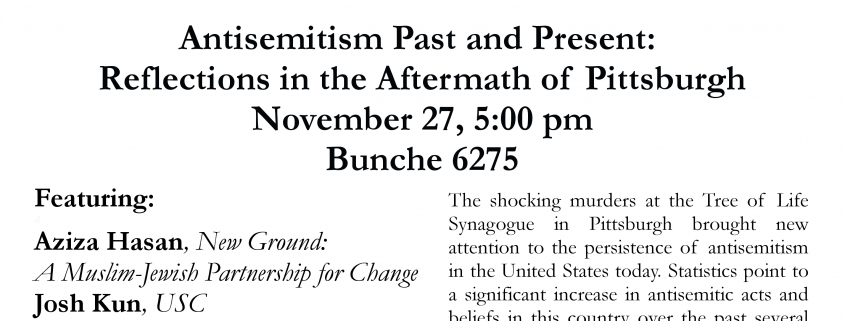
Luskin Center for History and Policy
“Antisemitism Past and Present: Reflections in the Wake of Pittsburgh”
November 27, 2018, Panel Discussion
Summary
LCHP hosted a panel entitled “Antisemitism Past and Present: Reflections in the Wake of Pittsburgh” on November 27, 2018. Panelists included Aziza Hasan (Executive Director, NewGround: A Jewish-Muslim Partnership for Exchange), Josh Kun (USC Annenberg School for Communication and Journalism), David N. Myers (UCLA Department of History), and Brenda Stevenson (UCLA Department of History). The panel was moderated by Jerry Kang (UCLA Vice Chancellor for Equity, Diversity, and Inclusion).
Each panelist began with a ten-minute statement of their perspective on antisemitism and their reflections after the shooting at the Tree of Life synagogue on Pittsburgh on October 27, 2018.
Professor Myers offered a brief summary of five major characteristics of antisemitism throughout history. First, antisemitism is ancient. In the premodern period, it was rooted in theological notions. In the modern period, it has been shaped by pseudoscientific theories of Jewish racial inferiority. Second, antisemitic imaginary is malleable. For example, Jews have been imagined as the masterminds of both capitalism and communism. Third, societies need a scapegoat, and Jews have often served as a social scapegoat. Fourth, antisemitism in the United States has been on a decline since WWII, but it has experienced a resurgence in the past two years. Fifth and final, there are a number of contemporary varieties of antisemitism, the most dangerous of which can be linked to movements that support right-wing nationalism.
Professor Stevenson discussed the relationship between antisemitism and anti-Black rhetoric and practices in the United States. She noted that the recent culture of violence against Black people and Jews in the United States is related to a history of institutionalized discrimination against both groups encoded in American law. Immigrant quotas and other anti-immigrant laws sought to prevent European Jews and other groups from coming to the United States, while institutionalized slavery and later Jim Crow laws provided the backdrop for ongoing discrimination and racism against Black Americans. In addition, a rhetoric that linked Blacks with Jews existed in the United States from the nation’s founding through the present day. Professor Stevenson concluded with the call for renewed and reinforced solidarity between discriminated peoples.
Aziza Hasan began by describing the work of her organization, NewGround: A Jewish-Muslim Partnership for Exchange. NewGround facilitates conversations between Muslims and Jews in the United States, teaching tools for dialogue with the goal of promoting understanding and reconciliation between the two groups. Hasan argued that, with the rise in both antisemitism and Islamophobia in recent years, the only solution to these problems is forging cross-group relationships and even friendships. Antisemitism, she suggested, is tied to White nationalism and therefore to all other kinds of hate. It is critical to promote dialogue and understanding between different groups, while seeking to protect discriminated populations through legal measures.
Professor Kun began by describing a trip he took to look at graffiti spray-painted along the California-Mexico border. The most common form of graffiti was the swastika. The second most common graffiti marking was phalluses. Professor Kun sought to dispel the image of California as a site of tolerance and acceptance, reminding the audience that California is home to 79 hate groups, many of which promote antisemitic beliefs that are related to toxic masculinity. His study of California graffiti demonstrates that different hatreds are constantly linked: misogyny is tied to antisemitism, which is tied to anti-Black racism and so forth.
After their initial presentations, Vice Chancellor Kang asked the panelists why it is often hard to promote solidarity between discriminated and hated populations when we know that these groups often share linked fates. Professor Myers, Professor Stevenson, and Ms. Hasan argued that the most important tool for promoting often elusive solidarity is by striving to assert the humanity in others, while nevertheless recognizing group differences. Professor Kun discussed the role that music, food, and other multimedia can play in promoting solidarity.
Another question was raised regarding the linkage between antisemitism and sexism. Ms. Hasan responded that these two hatreds are not always overlapping or tantamount, but they frequently give permission to each other to exist.
Another audience member asked how it is possible to create meaningful, rather than harmful, proximity between different groups. Professor Myers returned to his earlier point, suggesting that the best way to promote good proximity by recognizing cultural differences while asserting humanity in other groups. Professor Stevenson added that we must constantly push each other to ensure that cross-group conversations take place, even when it is difficult.



